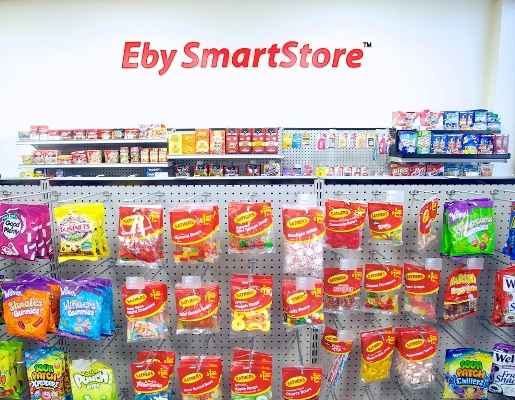
|
Tom Cinnamon is the man every candy maker should want to impress.
He’s Eby-Brown Co.’s v.p. of merchandising who’s in charge of deciding which new candies and snacks his company should stock and then distribute to the more than 13,500 retail locations it serves. It’s fair to say the man wields some power in the confectionery industry. Cinnamon, however, doesn’t exactly see it that way. To him, it’s all about the data.
“We really look at syndicated data. We’re looking at what are the best selling items in those areas,” he says, while explaining how Eby-Brown chooses which candies to stock at various retailers. “Our planograms are based on pure category management. They’re created by a combination of what consumers are purchasing and current industry trends.”
Cinnamon has been in his current position with Eby-Brown since March of 2011. Before that though, he worked in a wide range of roles within the distribution company, and has been with them for 27 years.
Eby-Brown is to distribution companies what Mars and Hershey are to chocolate. In fact, Eby-Brown is the largest privately owned distributor in the United States, with more than $5 billion in annual sales.
Owned by the Wake family for more than 55 years, the company is currently run by brothers Dick and Tom Wake. They serve 13,500 retail locations, out of seven distribution centers, and have 1.4 million-sq.ft. of warehouse space, and 2,000 employee members.
And, it’s where many of its typical convenience store customers get nearly 90 percent of their products — from candy to cigarettes to HBC to tobacco to grocery to automotive.
Offering data to even the smallest convenience stores

|
| Tom Cinnamon, v.p. of merchandising at Eby-Brown Co. |
Despite Eby-Brown’s size, the company offers the same level of data and insights to the smallest Independents as it does to the largest chains. All recommendations are created through the company’s Smart Process proprietary data that ensures all planograms are based on pure data (regional syndicated data, Eby-Brown data, and manufacturer-supplied data).
“We create quarterly publication titles called Category Insights that focus on key categories within the store and we inform our customers on key trends, performance and up-to-date planograms,” Cinnamon says. “All of our merchandising team has the most updated data and planograms to allow for on-site insights when retailers are looking for direction or answers. Eby-Brown truly does take a collaborative approach with the retailer and supplier, with the company serving as the nonbiased middle man.”
While acknowledging that some larger convenience store chains have those resources and do it on their own, “the majority of our customers are counting on us to help them select the right items for their stores. And it’s been a huge success,” he adds.
“We want to make sure the customers are carrying the right items because that’s the only way for them to grow their business and that’s how we’re going to grow our business,” Cinnamon explains. “We’re a wholesaler. We don’t own a convenience store. So the only way that we can make sure our customers are selling more products is to make sure they’re carrying the right products.”
Eby-Brown delivers to most of its convenience-store partners weekly — so as Cinnamon puts it, it’s better to sell them $4,000 worth of products than $2,000 because the truck is going to stop there no matter what.
How manufacturers can stand behind their products
So what can a candy manufacturer do to win Cinnamon over to get his or her products sold to those convenience stores? In short — they need to be willing to stand behind their products.
He drives home the point that manufacturers should develop a 360-degree program to fully support their products from the TV to the shelf. They need to stand behind their brands by providing both the local retailer and the wholesaler support. Manufacturers also need to make sure that the product is moving through the distribution channel.
“A lot of manufacturers make the mistake of spending a ton of money promoting their product on TV and through radio. But by the time they bring it to the trade, they’ve spent nearly all of their advertising dollars and they don’t know how to budget for promotional allowances at retail,” Cinnamon says. “There’s plenty of places to put your new items if you’ve got the items priced correctly and you stand behind them.”
Even Cinnamon has to rely on intuition sometimes though, to make sure he stays on top of new trends.

|
“Everyone knows about Mars and Hershey and their retailer programs and their advertising power. Basically if they’re getting their message out, and if they’re getting behind and supporting an item, we most likely need to carry that item,” he explains. “But with your newer manufacturers, that’s where we have to make sure that we’re getting them in here and we’re looking at their products… seeing if it’s something new or exciting.”
Since Eby-Brown is so big, he doesn’t have to go to many shows to find new products because so many companies come to see him. However, he says he does go to the Sweets and Snacks Expo, where he usually finds new items in the international section and from smaller, less visible vendors.
“It’s always good to see what other people are seeing and consumers are buying,” he explains.
Cinnamon says the confectionery industry is like a family — so much so that it’s even affected how he’s worked with manufacturers.
“It’s a very close group that really stops to takes the time to help each other,” he explains.” Even if there are certain manufacturers that we know that we can’t help, I’ll still sit down with them and give them advice about what markets they may fi t into, and discuss ideas about how to bring their products to C-store, such as different pack sizes and go-to-market strategies. Ideas about how they can be successful.”
How Eby-Brown lays out a store

|
| Eby-Brown's headquarters features a mock store, which allows customers to see how displays would look at their stores. |
Eby-Brown’s headquarters are nestled in a business park in suburban Chicago, in Naperville, Ill. Although most of the building is what you’d expect to find in a typical office space, the company also has a mock convenience store on the first floor that they call the SmartStore.
Set up to be taken apart at a moment’s notice, the SmartStore is there to show convenience store owners exactly how their stores will look with the products Eby- Brown distributes to them.
In the past, Eby-Brown’s customers would typically do this in a store where they would have to deal with cramped aisles, employees trying to do their jobs and customer traffic.
“They’d have all the manufacturers show up and all the brokers show up and help them set their stores. It’s a lot of chaos, and it takes a lot of time. We’ll actually do that for them,” Cinnamon says.
So, not only does Eby-Brown help the owners pick out the products, but they also plan out the entire setting of the store.
“We all know that the consumer is only in that store for a little over two minutes, so we have to make sure that when they walk into that store, it’s easy for them to shop and find the products that we know they’re looking for,” Cinnamon says. “So for us, it’s all about how that store is planogrammed.”
Candy, for example, is a huge impulse item. So it has to be basically in the customer’s face when they walk through the door.
“We have to make sure they have candy in the power rack - an under-the-counter rack for candy, as well as in line down the candy isle” Cinnamon explains. “But at the same time, making sure they don’t have too many of these points of interruption. Once you get more than three or four, you’re going to experience diminishing sales.”
After they see the mock set up, the owners can then make the final say about how things will look at their stores, all without ever disrupting a single minute of business at their stores.
“At the end of the day, it’s the retailer’s decision,” Cinnamon says. “But our data is based on what’s selling in their areas. We do not look at retailer rebates or anything like that. Generally, the customers will have a few changes to maximize their rebates and their own relationships with the manufacturers and brokers. Once the planograms are finalized, we’ll actually go out and have their stores set within four weeks.”
Once those are set up, the stores are ready to be stocked, which starts in the next step in the cycle for Eby-Brown. At that point, consumers, and C-store owners, and Eby-Brown can rest easy.







